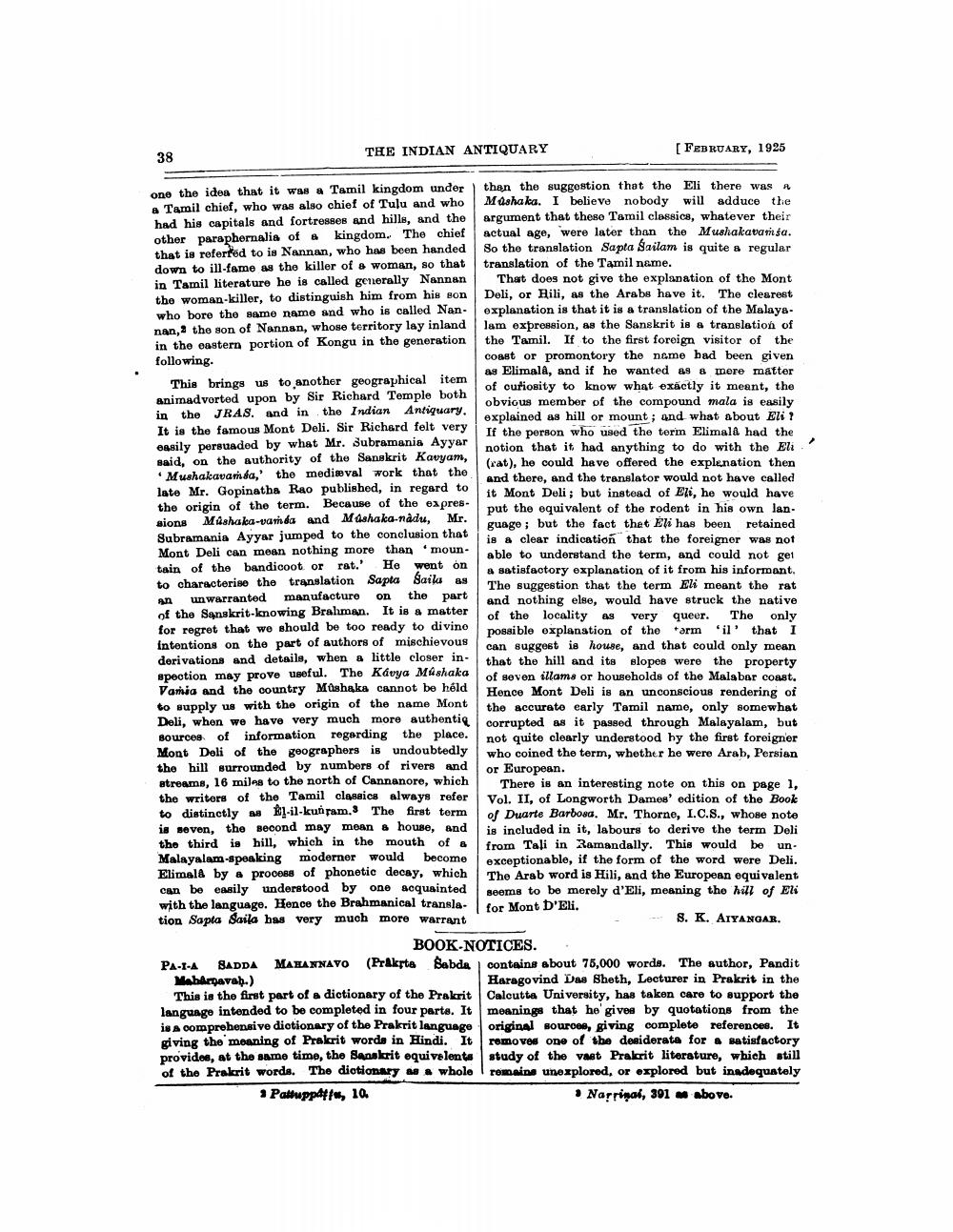________________
THE INDIAN ANTIQUARY
[FEBRUARY, 1925
38
ono the idea that it was a Tamil kingdom under then the suggestion that the Eli there was a & Tamil chief, who was also chief of Tulu and who Mashaka. I believe nobody will adduce the had his capitals and fortresses and hills, and the argument that these Tamil classics, whatever their other paraphernalia of a kingdom. The chief actual age, were later than the Mushakatamsa. that is referred to is Nannan, who has been handed So the translation Sapta Sailam is quite a regular down to ill-fame as the killer of a woman, so that translation of the Tamil name. in Tamil literature he is called generally Nannan That does not give the explanation of the Mont the woman-killer, to distinguish him from his son Deli, or Hili, as the Arabs have it. The clearest who bore the same name and who is called Nan. explanation is that it is a translation of the Malaysnan, a the son of Nannan, whose territory lay inland lam expression, as the Sanskrit is a translation of in the eastern portion of Kongu in the generation the Tamil. If to the first foreign visitor of the following.
coast or promontory the name had been given
as Elimala, and if he wanted 89 & mere matter This brings us to another geographical item
of curiosity to know what exactly it meant, the animadvorted upon by Sir Richard Temple both
obvious member of the compound mala is easily in the JRAS. and in the Indian Antiquary.
explained as hill or mount; and what about Eli ? It is the famous Mont Deli. Sir Richard felt very
If the person who used the term Elimalå had the easily persuaded by what Mr. Subramania Ayyar
notion that it had anything to do with the Eli said, on the authority of the Sanskrit Kavyam,
(rat), he could have offered the explenation then * Mushakavanda,' the medieval work that the
and there, and the translator would not have called late Mr. Gopinatha Rao published, in regard to
it Mont Deli; but instead of Eli, he would have the origin of the term. Because of the ea pres
put the equivalent of the rodent in his own lansions Mushaka-vanda and Mdahaka-nadu, Mr.
guage ; but the fact that Eli has been retained Subramania Ayyar jumped to the conclusion that
is a clear indication that the foreigner was not Mont Deli can mean nothing more than moun
able to understand the term, and could not get tain of the bandicoot or rat.' He went on
a satisfactory explanation of it from his informant. to characterise the translation Sapta Sailu as
The suggestion that the term Eli meant the rat an unwarranted manufacture on the part
and nothing else, would have struck the native of the Sanskrit-knowing Brahman. It is a matter
of the locality as very queer. The only for regret that we should be too ready to divino
possible explanation of the tarm il' that I Intentions on the part of authors of mischievous
can suggest is house, and that could only mean derivations and details, when a little closer in
that the hill and its slopes were the property spection may prove useful. The Kavya Mashaka
of seven illams or households of the Malabar coast. Vania and the country Mushaka cannot be held
Hence Mont Deli is an unconscious rendering of to supply us with the origin of the name Mont
the accurate early Tamil namo, only somewhat Deli, when we have very much more authentic
corrupted as it passed through Malayalam, but sources of information regarding the place.
not quite clearly understood by the first foreigner Mont Deli of the geographers is undoubtedly
who coined the term, whether he were Arab, Persian the hill surrounded by numbers of rivers and
or European. atreams, 16 miles to the north of Cannanore, which There is an interesting note on this on page 1, the writers of the Tamil classics always refer
Vol. II, of Longworth Dames' edition of the Book to distinctly as fl-il-kunram. The first term
of Duarte Barbosa, Mr. Thorne, I.C.S., whose note is seven, the second may mean & house, and is included in it, labours to derive the term Deli the third is hill, which in the mouth of a
from Tali in Zamandally. This would be un. Malayalam-speaking moderner would become
exceptionable, if the form of the word were Deli. Elimale by a procese of phonetic decay, which
The Arab word is Hili, and the European equivalent can be easily understood by one acquainted seems to be merely d'Eli, meaning the hill of Eli with the language. Hence the Brahmanical transla
18. | for Mont D'Eli. tion Sapta Saila bas very much more warrant
8. K. AIYANGAR. BOOK NOTICES. PA-I-A SADDA MAHANNAVO (Prakrta Sabda contains about 75,000 words. The author, Pandit Mahlzavah.)
Harago vind Das sheth, Lecturer in Prakrit in the This is the first part of a dictionary of the Prakrit Calcutta University, has taken care to support the language intended to be completed in four parte. It meanings that he gives by quotations from the is a comprehensive dictionary of the Prakrit language original sources, giving complete references. It giving the meaning of Prakrit words in Hindi. It romover one of the desiderata for a satisfactory provides, at the same time, the Sanskrit equivelents study of the vast Prakerit literature, which still of the Prakrit words. The dictionary as a whole remains unexplored, or explored but inadequately • Pattuppettu, 10
• Narrinal, 391 m above.




